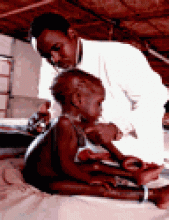Levels of health in the poorest countries, and in particular among the poor in these countries, remain unacceptably low.1 Worldwide, over 10 million children die each year before their fifth birthday.2 However, health has improved: if worldwide child mortality rates were equivalent to Canada's rates in 1900, there would be 30 million child deaths annually. Conversely, if Canada's current child mortality rates were found worldwide, only 1 million children would die each year. Progress has been steady in reducing child and maternal mortality, but the world is now in the midst of large and growing epidemics from HIV-1 and tobacco.
Health has improved in developing countries more rapidly over the last half century than it did in Western countries from the 17th century onward. The chief reason has been advances in technology and not — as many believe — improvements in income or education.3 Technological advances take many forms: vaccines against childhood and other diseases, better information about the hazards of smoking and the benefits of cessation, diagnostic tests for HIV-1 and short-course therapy for tuberculosis are examples. None would have been possible without high-quality scientific research. Yet despite the promise of knowledge to reduce premature mortality and poverty, only 10% of the world's health research resources go toward 90% of the diseases that burden the poorest countries.4
Rochon and colleagues5 in this issue (see page 1673) describe the paucity of randomized controlled trials (RCTs) addressing major global diseases. They reviewed 286 RCTs published in 6 international peer-reviewed general med ical journals to determine which evaluated conditions or diseases listed among the World Health Organization's leading causes of disease burden worldwide in terms of both mortality and disability-adjusted life years (DALYs). Less than half (43%) of the trials addressed any of the 35 leading contributors to global disease burden, with vascular dis ease and HIV/AIDS being the most studied condi tions. As well, 12 global health experts rated the relevance of the RCTs that focused on any of the top 10 causes of global burden of disease. The panel returned low ratings overall, judging only 1 in 6 of the selected RCTs to be highly relevant to global health.
Rochon and colleagues' findings help document the lack of evidence from RCTs being directed to global diseases. Comparable findings about research funding and products not matching disease burden have been documented for the US National Institutes of Health (e.g., proportionally, breast cancer research received much more funding than the disease's contribution to US burden of disease).6 Nevertheless, Rochon and colleagues' analyses, though carefully done, do not present a complete picture. First, RCTs represent only part of what is needed in global health research. For example, the efficacy of some interven tions, such as vaccination against childhood diseases (especially measles) and vaccination against hepatitis B for chronic liver cirrhosis and liver cancer, has been established by past RCTs. We know that some vaccines work, but we know less about how to deliver effective vaccines to populations where vaccine coverage is low. Operational research might be better than RCTs to address such gaps in global evidence.4
Second, experts bring their own biases to bear when judging the “relevance” of evidence from RCTs. Many who work in global health perceive interventions for maternal and childhood conditions as being more relevant than those for chronic diseases of adults,7 but this logic is often misguided. For example, there are 13 million deaths from vascular disease in developing countries as compared with 3 million in developed countries,8 and such deaths in developing countries are often concentrated among younger people and the poor. The experts in the study by Rochon and colleagues, even though they used a well- designed and standardized method to give their ratings, gave the lone randomized trial of road-traffic accidents the lowest relevance rating, despite the top-10 status of road-traffic accidents in both DALYs and mortality. There is, of course, no easy way to judge priorities. Quantitative burden estimates help, but expert ratings are more problematic.
Finally, although publishing RCTs in high-profile general medical journals undoubtedly has some bearing on the impact of the research, by focusing solely on general medical journals Rochon and colleagues may underestimate the extent of specialization in global health research and therefore the amount of relevant and high-impact research that might be published through specialty journals.
Nonetheless, the analyses by Rochon and colleagues help to point out that not enough research, including RCTs, is being done into the diseases in developing countries. There is renewed interest in Western countries in making a serious dent over the next 2 decades in the major diseases of the global poor. However, in this era of globalization and “outsourcing,” the lack of randomized studies in developing countries is notable. Barriers include complex ethical challenges, such as those revealed by the randomized HIV-1 perinatal transmission trials in developing countries in the early 1990s,9 skepticism of Western regulatory agencies of drugs and devices tested outside of high-income countries and limited research capacity in developing countries. But these barriers are not insurmountable. Making any serious improvement in mortality and disability among the global poor will require much more research, some of it employing randomized designs, into the few major diseases that explain much of the gap between rich and poor countries. Priorities include accelerating declines in childhood and maternal mortality, getting adult smokers worldwide to quit1 and, most notably, curbing the growth of HIV-1.10
𝛃 See related article page 1673
Footnotes
-
This article has been peer reviewed.
Contributors: Both authors drafted and revised the article and approved the final version.
Competing interests: None declared.
Correspondence to: Dr. Prabhat Jha, Director, Centre for Global Health Research, St. Michael's Hospital, University of Toronto, 70 Richmond St. E, Third floor, Toronto ON M5C 1N8; fax 416 864-5256; prabhat.jhautoronto.ca











